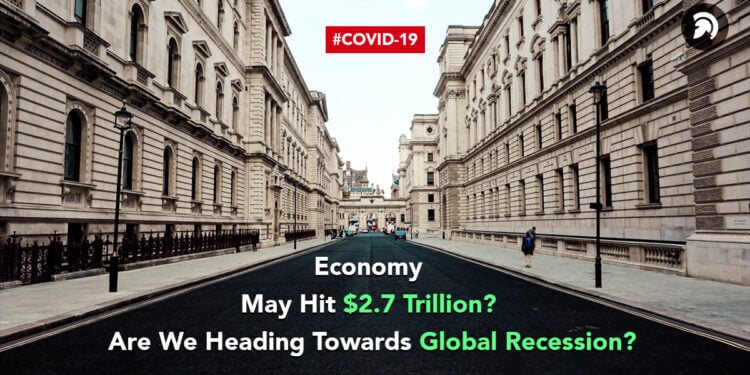Listen to The Most Important Information related to COVID-19 through our Blog’s Podcast here !!
The official namesaking process is finished. It’s a “pandemic.” Major economies have stumbled like the once old Humpty Dumpty.
In the last few days, the global economy has seen a high fall & a little rise as one of the ongoing consequences of the virus epidemic. Every major one of them is contracting so far whether you name the U.S. or Europe or China economy. For example, the U.S economy is projected to slide by 14% in the second quarter, which is currently slipped by 4%. On the other hand, Europe’s GDP is expected to fall by 15% & 22% in the first & second quarters respectively.
We can conclude that the longest streak of the rising sun for Global Expansion is going to set by this quarter. Many economist’s views are also concluding that the global recession is due to the COVID-19 pandemic. Are we heading towards one?
However, a few others think that there is still time. Whichever it may be, only the time will tell. But for now, let’s evaluate what is happening around us? And more importantly, what to expect from the future?
Before we move forward, let us draw our attention in this critical time as the recent confirmed global numbers have increased to 2,169,022 out of whom 146,071 lives lost and 552,264 recovered. Help is on the way from government & banks, reducing the interest rates to private sectors and corporates offering packages. Last but not least, the generous donation to maintain the world equilibrium in every aspect.
In the past few days, we have seen a couple of short bounces in the numbers, but nothing worth noticing. The Global financial markets saw a drop-dead downfall over the spread of novel coronavirus whose impact is going to last long. And what seems to be the reason behind it? Only if you try to look at the big picture.
Big Picture For The Regional & Global Markets
One might ask why financial markets are focussing more on coronavirus than any other deadly flu, which has taken away more lives? It’s simple. Because the others are known, and COVID-19 carries that ‘unknown’ tag with it. Hence, we are not sure how much further the virus’s uncertainty will disrupt everyday life & business.
This uncertainty of the COVID-19 global pandemic has already posed a significant threat, which is causing government, businesses & trade houses to take preventive measures.
The current regional & global market impact comes closest to the SARS coronavirus of 2003. The situation was similar to the SARS impact that had hit the domestic & global market, slowing economic growth. If we look at the big picture & understand, it might give us a slow head start, but if we can still manage the global GDP growth forecast for 2020 to 2.9% instead of 3.1%.
It also means that the response to global monetary policy will play a significant role in handling the coronavirus pandemic outbreak. Policymakers introducing various funding facilities and financial institutions revising interest rates are a few of the measures a few governments are trying to focus on primarily. While another perspective says that rate cuts and higher spending will help put a floor under fragile financial markets and revive demand once the crisis is over. However, looking at the plausible scenario, it is not sure which kind of monetary policies will work to strengthen the economy. For now, only the constructive efforts with help to bridge the gap in the marketplace left by COVID-19.
How much ever small it may seem with, we cannot underestimate looking at how it has showcased ripples of recession in just the first of this year’s quarter. Let’s understand what it means majorly for the U.S & China economy.
Coronavirus – Created Ripple of Recession for the 1st half of 2020
The virus pandemic that began in China leads to its slowest growth on record affecting the industrial and production output in trillions. Major business sectors of China are affected whether the regional manufacturing component factory to multinationals, who are having operations running in China.
One thing now to understand is that no matter how strong an individual economy can be, the globalization wave that we rode has left it inter-connected. Hence, whether it is the U.S or China or any other, such situations can significantly be going to create a global impact.
E.g., a U.S car company relying on a company from China for a few car components to import from China. But the trade isn’t possible because the factory is shut down, which will affect the carmaker’s production capacity. A few reports and research is still ongoing, evaluating the Inter-Country Input-Output.
For now, it certainly leaves a lesson for businesses and trade houses to work together and integrate digital solutions to their business to be well equipped and better prepare ourselves in situations like these. However, other such global risks are lurking over as per the World Economic Forum – Global Risks Reports 2020. Let’s have a glance over it:
Coronavirus & Other Global Market Risks Overview
The Global Risks Reports 2020 from the ‘World Economic Forum’ classify the following as the dominant global market risks for now and the future.
- Economic – Such as deflation, illicit trade, fiscal crises, financial failure, asset bubble.
- Environmental – Such as climate action, natural & human-made ecological disaster.
- Geopolitical – such as interstate conflict, weapons of mass destruction, global governance failure, and state collapse.
- Societal – Such as food & water crises, infectious diseases, social instability.
- Technological – Such as cyberattacks, data theft, information infrastructure breakdown.
From the excerpts of the Global Risks Reports, it is quite clear that it is high time now to find a breakthrough in the current outbreak and try to bring back the global business cycle to normalcy. But is there a turn-around time for the economy to get back on and how?
When The World Business Cycle Will Paddle Again?
As far as the ongoing global market situation is concerned, some industry pundits see it as a usual economic or perhaps business cycle period. Starting from recovery to expansion, to overheating, to the recession. The comeback of the financial market depends over the next 6 to 12 months of the investment horizon.
In the past few decades, there has been an acceleration in the supply chain integration and financial systems, which mainly lead to the globalization phenomenon. This basically can be regarded as an expansion period that seems to be disrupted now with COVID-19. There are other factors as well, which might contribute to the global recession. A global recession can be considered insight by looking at equity bear markets or loss in global stock value over a short period, etc.
The current state of the business cycle is still unclear as the effects of COVID-19 is still engulfing & surrounding our world with the lockdown. The core factors that drive an economic cycle will be based on job creation, debt & inventory build-ups, monetary and fiscal policies while not including the other such threats such as unknown coronavirus.
How To Get The Global Business Cycle On Track?
The global business is based on many economies. Each country has its economic models. These economic models derive the business cycle dynamics fundamentally, which naturally tends to differ from each other.
In the wake of such a scenario, the only global language that cuts through every challenge is technology. Yes, digital automation in every industry sector will transform the way we work. This also will help to handle the situation on hands like the COVID-19 coronavirus pandemic. May it be operating transport, logistics, or supply chain business digitally or healthcare tech, retail, etc. – infusing digital automation will undoubtedly help to cope up with threats like coronavirus.
Accelerating digital transformation will undoubtedly help us to an extent to tackle environmental, economic, and above all, societal factors to limit the spread of any infectious disease. Amidst all of this, how does the picture of global growth look like? Let’s have a glimpse on the Global Growth Outlook.
Global Growth Outlook
Though playing mainly at the hand of unexpected supply and demand shock – coronavirus has seemed to have affected globally. Whether it is Europe’s global tourist spending or the U.S sports & entertainment industry – each activity is seeing the effect of COVID-19.
As per the Chief U.S. economist, Michael Feroli – “Overall, we think the consumer spending categories that are most at risk of virus-related disruptions account for around 7% of GDP”. On the other hand, even China has confirmed that the rebound in the second quarter will not be enough to offset first-quarter losses.
We need to put effort into limiting this negative shock of the first quarter. The fear of coronavirus is simple enough to bring down stocks, government, trade, business, and the economy in just a matter of weeks. The unexpected demand shock with a topping of supply shock due to more extended factory shutdowns will influence a lot in deciding global growth.
Wrap Up:
We all are certainly sailing in the same boat. We understand. But we have not given up. We are here for you. We want that technology to integrate with every business and trade. Because doing so will allow us to counter the threat and stop it before it creates another global impact, let’s spend 90 minutes understanding your business platform and our digital solution about the same.




